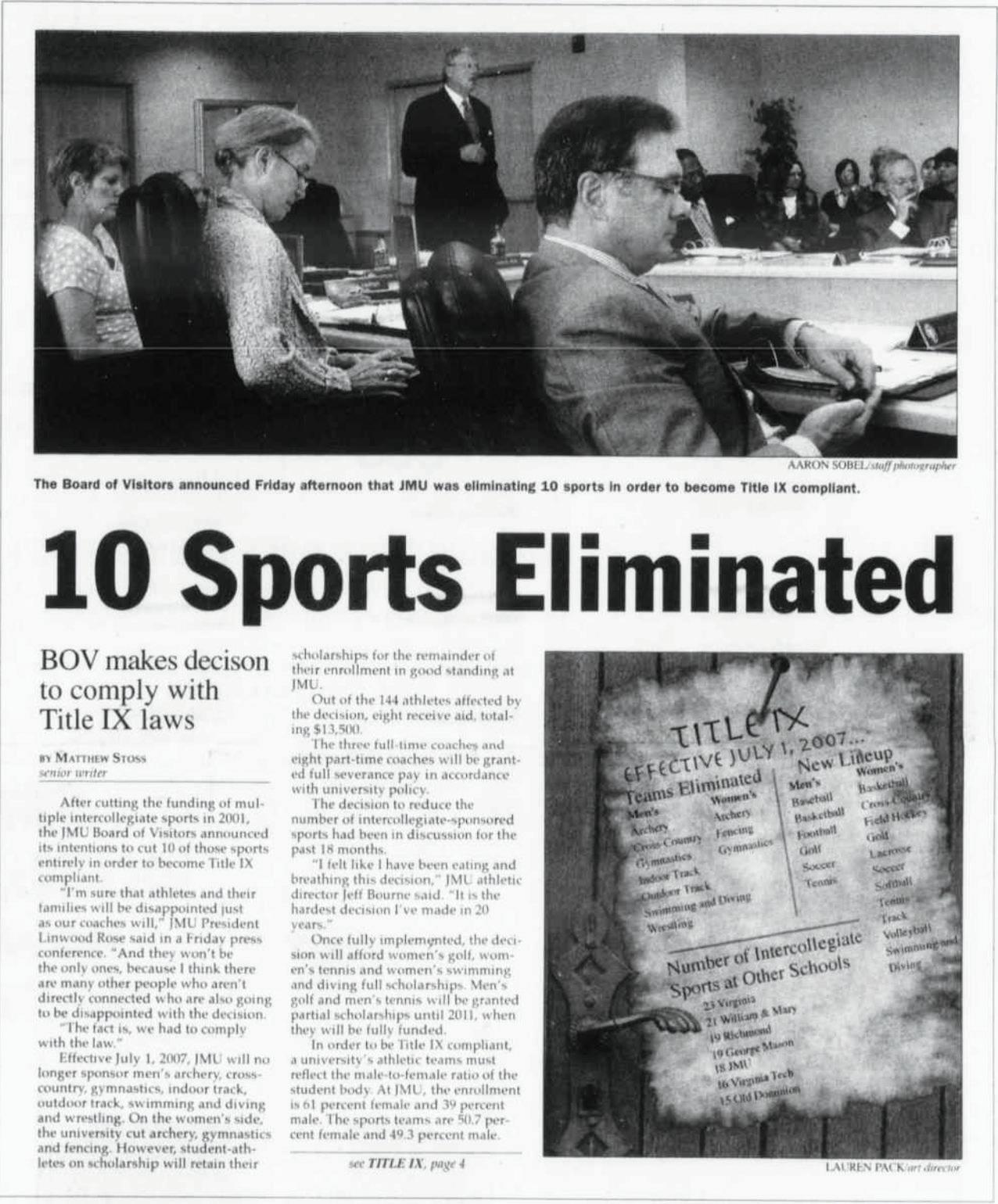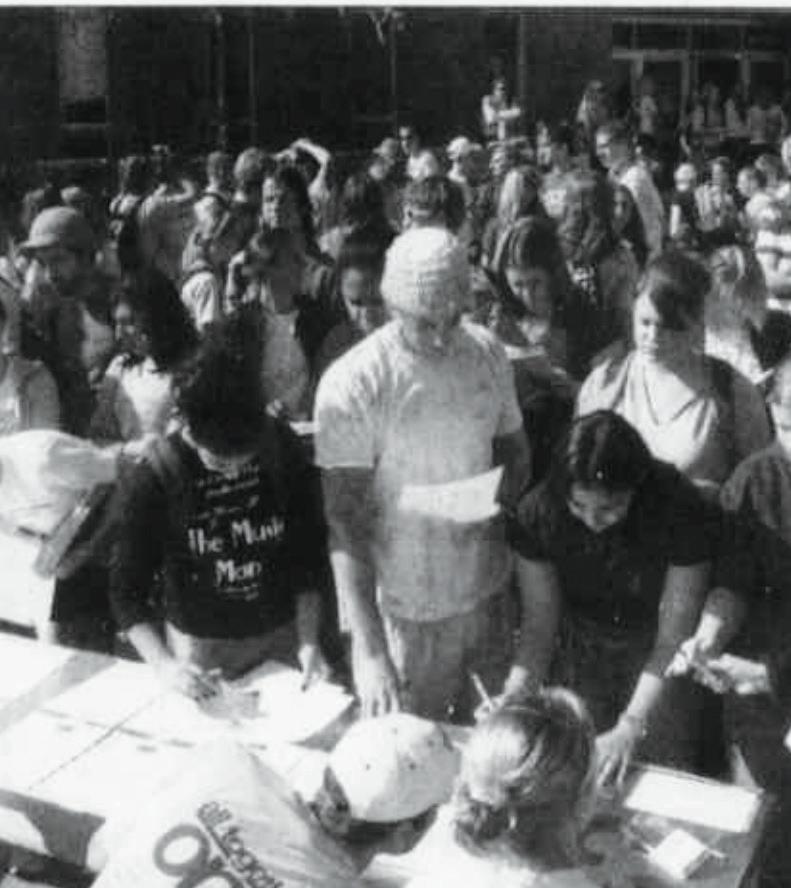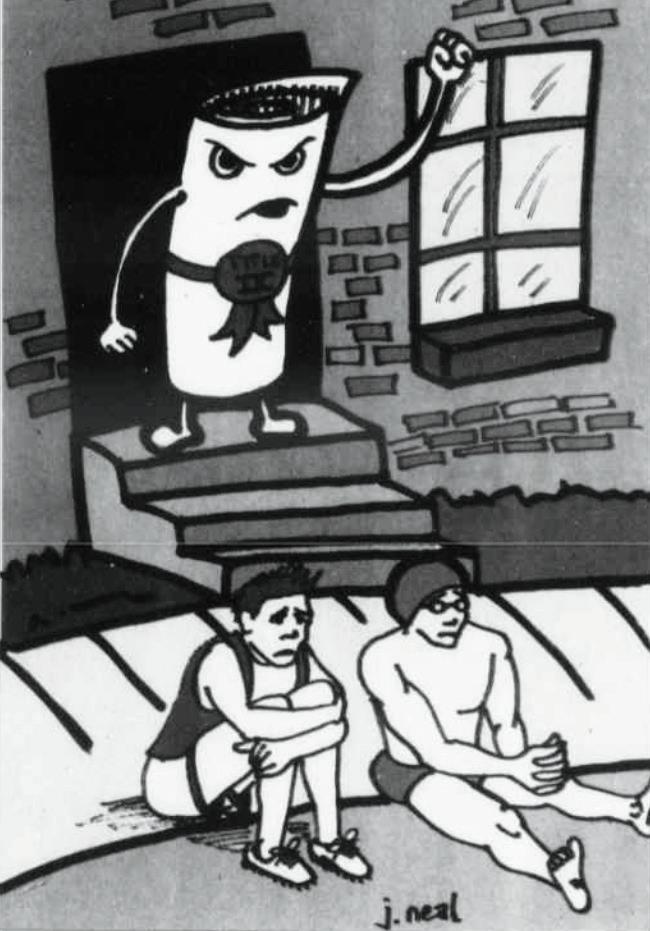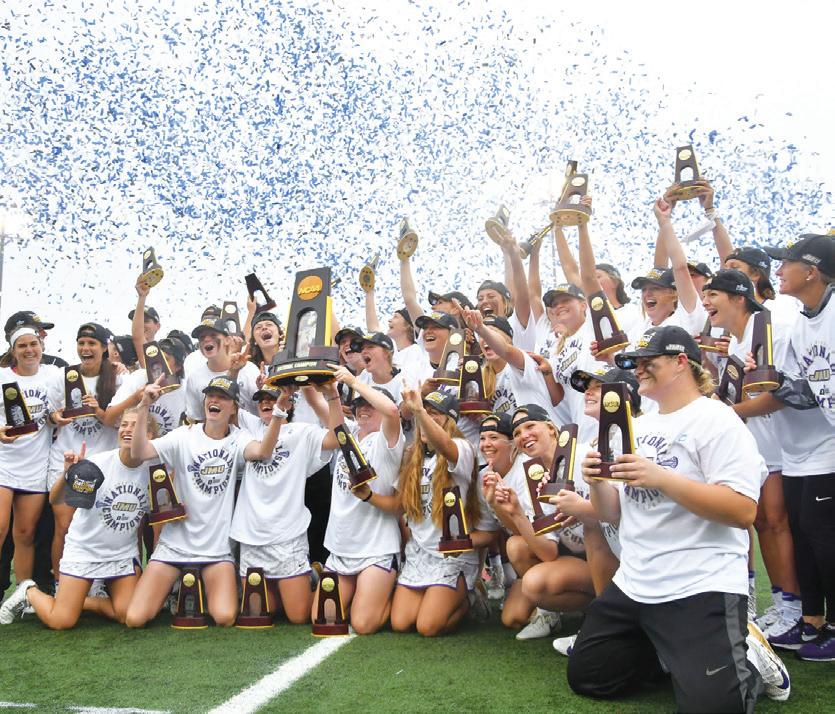
9 minute read
‘The hardest decision’
from The Breeze 2.23.23
by The Breeze
from TITLE IX, page 1
If universities want federal funds, they must adhere to at least one of three requirements outlined in Title IX:
Advertisement
1. The percentage of intercollegiate athletes has to match the make-up of the university’s student body.
2. A school must show it meets athletic interests and abilities of underrepresented students.
3. A school must show it expands its opportunities for underrepresented students.
JMU chose Option 1. Seven of the 10 sports JMU cut in 2007 were men’s sports — swim & dive, cross country, indoor and outdoor track and field, cross, gymnastics, wrestling and archery — and three were women’s sports: gymnastics, fencing and archery. Bourne said this kept JMU in compliance with Title IX.
“I felt like I had been eating and breathing this decision,” Bourne said in an interview with The Breeze in 2006. “It’s the hardest decision I’ve made in 20 years.”
Bourne said the decision didn’t come easily or on a whim — it stretched over 18 months.
So let’s start there.
According to a 2001 article from The Washington Post, JMU’s student body was 58% female at the time, but its athletics’ teams were only 41% female. JMU was in compliance with Title IX, but it still chose to create a two-tiered system of scholarship and nonscholarship sports.
The university downgraded 12 of JMU’s 28 sports — men’s swimming, indoor and outdoor track and field, cross country, golf, wrestling, tennis and gymnastics, and women’s swimming, golf, tennis and gymnastics — to a nonscholarship status. At the time, three additional sports, fencing and men’s and women’s archery, were already nonscholarship programs.
The Board of Visitors’ vote to move the 12 sports was unanimous, according to The Breeze’s report in 2001, and created the twotiered system between the scholarships and nonscholarship sports. Bourne said JMU looked into making cuts in 2001 and, upon talking with the Board of Visitors, he said the university decided the time wasn’t right.
“We were fine there. We had added softball, we have added women’s soccer, we’ve done things to add some sports over time,” Kevin Warner, assistant athletic director for communications, said. But “our proportion was out of line” with JMU’s student body, Warner added, because the number of athletes in 2001 was 50.7% women and 49.3% men.
“If a group brought legal action against you, basically, you would not win that legal action, Warner said. “We were not in proportion of female athletes and female student body. I mean, technically, you’re only at risk until someone can bring legal action, and the threat was we had women’s clubs, sports that were pushing to become varsity sports, and we would have had to do something.”
Bourne said football has about 100 athletes, that number equalling four to five women’s teams. He said JMU was “in a tough spot” to say no to the petitioning sports clubs.
The issue with having to add those sports and adhere to the second or third elements of Title IX was that JMU wasn’t able to afford them. Bourne said JMU’s student enrollment was about 61% female and 39% male in 2006.
“To either add sports or legally to meet Title IX, we would have had to cut women’s sports,” Warner said. “And that’s where the hand was forced then. OK, the budget isn’t there to add sports, we had to cut sports.”
Bourne said the sports being discussed for possible elimination all went into “fundraising mode.” He said that even though looking at potential programs, they could’ve been successful and competitive immediately, the budget didn’t have the space for resources the programs needed, even with fundraising.
“We’ll raise the resources to support our programs,” Bourne said. “We won’t require state dollars for that. Even though they tried, that’s almost an impossible task.”
And it left JMU with a difficult, but stark, reality.
From there, in 2006, Bourne said JMU had to talk to coaches. He said he wanted to make sure the coaches heard it from him and not through phones or social media, since it was just starting to take off. Bourne said he had to coordinate an effort to make sure everyone heard at the same time.
“The last thing you want to do is hear that from someone that is not affiliated,” Bourne said. “It was challenging. It was a very lengthy, painful process to go through. It was a tough meeting, I think, on both sides. But we talked through the issues. I don’t know that folks really fully understood or [knew] why the decision was made, and didn’t want to hear that, probably.”
The immediate response and pushback
Once the decision struck, there were tears, anger and pure confusion.
“Our hopes and dreams were crushed,” then-senior wrestler Zach Winfrey said to The Breeze in 2006. “You could see it on everyone’s face.”
JMU Athletics tried to do what it could to continue supporting the athletes who faced the decision’s consequences, Bourne said.
Scholarships were honored for those affected through the remainder of their time at the university, and the University Recreation Center (UREC) helped the cut sports’ transition from varsity to club — where many of those sports remain today.
The decision also led to the reinstallation of fully funded scholarships across the remaining 18 sports. Sixteen of those were fully funded by July 1, 2007, and men’s golf and tennis were given partial scholarships until 2011 before becoming fully funded.
But the athletes weren’t satisfied with it.
“At first, everyone was pissed,” Freitag said. “Then there was a little bit of denial. We kept trying to figure out different ways that we could maybe get them to delay it or rethink it or, you know, somehow that we were going to be competing next year.”
Freitag, the men’s swimmer, spent his time at JMU trying to find a way to continue competing, even after the men’s swim program was cut. His goal was to eventually go to North Carolina State for graduate school for his final year of eligibility.
He calls himself a “creature of habit” who likes having a routine every day. But once the cuts were made, he didn’t have that constant routine. There were no scheduled practices, no competitions and no coaches, and Freitag was on his own.
Freitag worked with current JMU swim and dive head coach Dane Pedersen — who was an assistant coach at the time — to train with the women’s program, but his academics suffered. He didn’t get into NC State like he had hoped to.
“I was the worst student,” Freitag said. “It kind of really scared me straight and I had to find my identity again.”
Other athletes tried to find a way for JMU Athletics to reinstate the sports and as the July 1, 2007, date loomed, the athletes continued trying to figure out a way to keep their sport where it was.
Jenn Chapman, a former track and field athlete (2003-07) and president for the Student Athlete Advisory Committee (SAAC), helped lead some of the protests athletes held and found ways for different programs to support one another.

She spoke in front of the Board of Visitors and sold T-shirts, she even had the football team cheer on the women’s gymnastics program at a meet, singing “The Roof is On Fire.” Chapman later received the All Together One award in 2007, given to a member of Omicron Delta Kappa for excellence in leadership and character, for her efforts with the other programs.
“She has offered us hope and helped us through this difficult process,” former gymnast Natalie Moore (2004-07) said in her nomination letter to Omicron Delta Kappa. “She has come to many of our practices and talked to us about the issue. Jenn’s track team was not even one of the teams that were cut, but she has still supported all of the teams. She has come to every home competition that these teams have had.”
Equity in Athletics Inc., a not-for-profit nonstock corporation, took on litigation against JMU, taking the case through the U.S. Court of Appeals and attempted to have the U.S. Supreme Court hear the case in 2009. The Supreme Court refused to hear the case, according to a 2009 article from The Breeze.
“I think people still hoped that we were going to compete that next year,” Freitag said. “I don’t necessarily think that after that initial anger set in that it really hit until the official … cuts were made.”
2023 impacts: In Harrisonburg and beyond
Bourne recently attended an NCAA convention. He said there wasn’t an hour that went by where the conversation wouldn’t circle back to, “How many more years can programs across the board be supported? Without some adjustments?”

He said “adjustments,” in this sense, means conference realignment.
JMU moved to the Sun Belt Conference and the FBS in July 2022. With the move to the FBS, JMU now has 22 more football scholarships to offer. Warner said the move involved conversations with JMU Athletics’ Title IX consultant to make sure it could take on these new scholarships without having to add a new sport.
“We had to do the work well in advance with our FBS feasibility study,” Warner said. “In our consult on this study, we were able to say … ‘we’re OK.’ That was a big piece because I don’t know, realistically, if the Sun Belt FBS move can happen if we’re also having to add sports on top of it to make it happen.”
About once a week, Warner said, JMU hears about adding men’s lacrosse.
The sport is sponsored in the CAA, JMU’s former conference, and with the success of JMU’s women’s lacrosse program, Warner said people have thought for a long time that a men’s team can be successful.

Men’s lacrosse as a club team has been successful — in 2021-22, the Dukes were 7-2 in the Men’s Collegiate Lacrosse Association (MCLA) and, according to their homepage, have about 50 active members. The MCLA functions similarly to the NCAA, although it operates at the club level, with All-Americans and eligibility rules. JMU qualified for the conference playoffs in 2021-22.
Warner said since the Sun Belt added beach volleyball, people ask about that too. However, if JMU is going to commit to a sport, Warner said, it’s going to do it the right way: committing to Title IX and resources, he said.
“We already operate this department at such a high level resource-wise, financially,” Warner said. “We’re only going to do it if they can be successful and do it the right way. I think it’s fair to say we’re not in a place that we can add those sports, maintain the Title IX compliance, do it the right way fully.”
Bourne said because of the cuts, the resources are now spread more equally across the board. Scholarships were reinstated and JMU got out of the two-tiered system, Warner said, and sports had full-time coaching staffs and equipment.
Warner cited women’s tennis as an example of this. While “unfortunate,”
Warner said, regarding the cut scholarships, the team eventually had scholarships reinstated, the coaching staff compensated and cost of attendance set.
“We got up to the point a few years ago, before COVID, where we won our first CAA Championship ever,” Warner said, “they’re moving on to NCAA play for the first time in the program’s history. That’s a program, then, that’s gotten to that elevated point that they could do that. You don’t want to be in a place where you’re part of our athletics program, but you really don’t have what you need to compete and win championships.”
Lacrosse and softball, in the years since the cuts, have both won multiple conference championships and made noise in the NCAA tournament. Lacrosse won the 2018 National Championship and softball made a final four appearance in the Women’s
College World Series.
In addition to the success of intercollegiate programs, the cut sports have seen success, too. Former JMU archer Jacob Wukie (’09) stayed in the archery program as it moved over to UREC. Warner said Wukie won multiple national championships at the club level, took a year off in 2008, then returned to JMU in 2009 and later made Team USA and competed in multiple Olympic games. In its final year as a varsity program, Wukie, then just a freshman, helped led the team to a national title.
“It’s a testament to him and his fortitude to get through this situation,” Warner said.
This fall, Wukie will be honored in the JMU Athletics Hall of Fame. He’s not the first athlete to make the hall of fame from sports that were cut, either. Recently, Anthony Wallace (’03) was a part of the 2022 class for men’s track and field.
“We’re gonna get to celebrate him this coming fall,” Warner said. “It was obviously difficult to go through but I think it’s a testament to him and the opportunities he gets.”
Freitag said he felt “hatred” toward JMU for a long time. He said he ignored messages about donations, he doesn’t keep in touch with his former coaches and teammates too much and he didn’t follow most sports once he graduated, except for swim and dive. Freitag said he sends Pedersen a note during conference championships, saying he’s rooting for the team that supported him.
But since the Sun Belt move, Freitag said he’s starting to pay attention a little bit more. It intrigued him enough to consider coming back to campus for the first time. It’s taken a long time, he said, to feel healed from what happened 16 years ago.
“I had a lot of hatred, as I started to find my own identity outside of athletics,” Freitag said. “It’s a slow process, but I’m slowly getting there.”
CONTACT Madison Hricik at breezesports@ gmail.com. Contact Savannah Reger at thebreezeweb@gmail.com. For more sports coverage, follow the sports desk on Twitter @TheBreezeSports.










